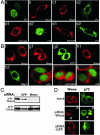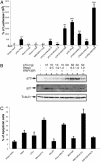Functional association between Wwox tumor suppressor protein and p73, a p53 homolog
- PMID: 15070730
- PMCID: PMC384759
- DOI: 10.1073/pnas.0400805101
Functional association between Wwox tumor suppressor protein and p73, a p53 homolog
Abstract
The WWOX gene is a recently cloned tumor suppressor gene that spans the FRA16D fragile region. Wwox protein contains two WW domains that are generally known to mediate protein-protein interaction. Here we show that Wwox physically interacts via its first WW domain with the p53 homolog, p73. The tyrosine kinase, Src, phosphorylates Wwox at tyrosine 33 in the first WW domain and enhances its binding to p73. Our results further demonstrate that Wwox expression triggers redistribution of nuclear p73 to the cytoplasm and, hence, suppresses its transcriptional activity. In addition, we show that cytoplasmic p73 contributes to the proapoptotic activity of Wwox. Our findings reveal a functional cross-talk between p73 and Wwox tumor suppressor protein.
Figures




References
-
- Bednarek, A. K., Laflin, K. J., Daniel, R. L., Liao, Q., Hawkins, K. A. & Aldaz, C. M. (2000) Cancer Res. 60, 2140–2145. - PubMed
-
- Ried, K., Finnis, M., Hobson, L., Mangelsdorf, M., Dayan, S., Nancarrow, J. K., Woollatt, E., Kremmidiotis, G., Gardner, A., Venter, D., et al. (2000) Hum. Mol. Genet. 9, 1651–1663. - PubMed
-
- Kuroki, T., Trapasso, F., Shiraishi, T., Alder, H., Mimori, K., Mori, M. & Croce, C. M. (2002) Cancer Res. 62, 2258–2260. - PubMed
-
- Yendamuri, S., Kuroki, T., Trapasso, F., Henry, A. C., Dumon, K. R., Huebner, K., Williams, N. N., Kaiser, L. R. & Croce, C. M. (2003) Cancer Res. 63, 878–881. - PubMed
Publication types
MeSH terms
Substances
LinkOut - more resources
Full Text Sources
Molecular Biology Databases
Research Materials
Miscellaneous

